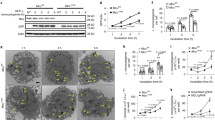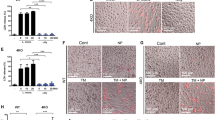Abstract
Listeria monocytogenes is an intracellular bacterial pathogen that replicates rapidly in the cytosol of host cells during acute infection1. Surprisingly, these bacteria were found to occupy vacuoles in liver granuloma macrophages during persistent infection of severe combined immunodeficient (SCID) mice2. Here we show that L. monocytogenes can replicate in vacuoles within macrophages. In livers of SCID mice infected for 21 days, we observed bacteria in large LAMP1+ compartments that we termed spacious Listeria-containing phagosomes (SLAPs). SLAPs were also observed in vitro, and were found to be non-acidic and non-degradative compartments that are generated in an autophagy-dependent manner. The replication rate of bacteria in SLAPs was found to be reduced compared to the rate of those in the cytosol. Listeriolysin O (LLO, encoded by hly), a pore-forming toxin essential for L. monocytogenes virulence1, was necessary and sufficient for SLAP formation. A L. monocytogenes mutant with low LLO expression was impaired for phagosome escape but replicated slowly in SLAPs over a 72 h period. Therefore, our studies reveal a role for LLO in promoting L. monocytogenes replication in vacuoles and suggest a mechanism by which this pathogen can establish persistent infection in host macrophages.
This is a preview of subscription content, access via your institution
Access options
Subscribe to this journal
Receive 51 print issues and online access
$199.00 per year
only $3.90 per issue
Buy this article
- Purchase on Springer Link
- Instant access to full article PDF
Prices may be subject to local taxes which are calculated during checkout




Similar content being viewed by others
References
Portnoy, D. A., Auerbuch, V. & Glomski, I. J. The cell biology of Listeria monocytogenes infection: the intersection of bacterial pathogenesis and cell-mediated immunity. J. Cell Biol. 158, 409–414 (2002)
Bhardwaj, V., Kanagawa, O., Swanson, P. E. & Unanue, E. R. Chronic Listeria infection in SCID mice: requirements for the carrier state and the dual role of T cells in transferring protection or suppression. J. Immunol. 160, 376–384 (1998)
Kayal, S. & Charbit, A. Listeriolysin O: a key protein of Listeria monocytogenes with multiple functions. FEMS Microbiol. Rev. 30, 514–529 (2006)
Shaughnessy, L. M., Hoppe, A. D., Christensen, K. A. & Swanson, J. A. Membrane perforations inhibit lysosome fusion by altering pH and calcium in Listeria monocytogenes vacuoles. Cell. Microbiol. 8, 781–792 (2006)
Myers, J. T., Tsang, A. W. & Swanson, J. A. Localized reactive oxygen and nitrogen intermediates inhibit escape of Listeria monocytogenes from vacuoles in activated macrophages. J. Immunol. 171, 5447–5453 (2003)
del Cerro-Vadillo, E. et al. Cutting edge: a novel nonoxidative phagosomal mechanism exerted by cathepsin-D controls Listeria monocytogenes intracellular growth. J. Immunol. 176, 1321–1325 (2006)
Pamer, E. G. Immune responses to Listeria monocytogenes . Nature Rev. Immunol. 4, 812–823 (2004)
Perrin, A. J., Jiang, X., Birmingham, C. L., So, N. S. & Brumell, J. H. Recognition of bacteria in the cytosol of Mammalian cells by the ubiquitin system. Curr. Biol. 14, 806–811 (2004)
Hamon, M., Bierne, H. & Cossart, P. Listeria monocytogenes: a multifaceted model. Nature Rev. Microbiol. 4, 423–434 (2006)
Henry, R. et al. Cytolysin-dependent delay of vacuole maturation in macrophages infected with Listeria monocytogenes . Cell. Microbiol. 8, 107–119 (2006)
Jankowski, A., Scott, C. C. & Grinstein, S. Determinants of the phagosomal pH in neutrophils. J. Biol. Chem. 277, 6059–6066 (2002)
Hackam, D. J. et al. Regulation of phagosomal acidification. Differential targeting of Na+/H+ exchangers, Na+/K+-ATPases, and vacuolar-type H+-ATPases. J. Biol. Chem. 272, 29810–29820 (1997)
Gordon, A. H., Hart, P. D. & Young, M. R. Ammonia inhibits phagosome–lysosome fusion in macrophages. Nature 286, 79–80 (1980)
Yamamoto, A. et al. Bafilomycin A1 prevents maturation of autophagic vacuoles by inhibiting fusion between autophagosomes and lysosomes in rat hepatoma cell line, H-4-II-E cells. Cell Struct. Funct. 23, 33–42 (1998)
Beauregard, K. E., Lee, K. D., Collier, R. J. & Swanson, J. A. pH-dependent perforation of macrophage phagosomes by listeriolysin O from Listeria monocytogenes . J. Exp. Med. 186, 1159–1163 (1997)
Alberti-Segui, C., Goeden, K. R. & Higgins, D. E. Differential function of Listeria monocytogenes listeriolysin O and phospholipases C in vacuolar dissolution following cell-to-cell spread. Cell. Microbiol. 9, 179–195 (2007)
Birmingham, C. L. et al. Listeria monocytogenes evades killing by autophagy during colonization of host cells. Autophagy 3, 442–451 (2007)
Kuma, A. et al. The role of autophagy during the early neonatal starvation period. Nature 432, 1032–1036 (2004)
de Chastellier, C. & Berche, P. Fate of Listeria monocytogenes in murine macrophages: evidence for simultaneous killing and survival of intracellular bacteria. Infect. Immun. 62, 543–553 (1994)
Brumell, J. H., Rosenberger, C. M., Gotto, G. T., Marcus, S. L. & Finlay, B. B. SifA permits survival and replication of Salmonella typhimurium in murine macrophages. Cell. Microbiol. 3, 75–84 (2001)
Kaniuk, N. A. et al. Ubiquitinated-protein aggregates form in pancreatic beta-cells during diabetes-induced oxidative stress and are regulated by autophagy. Diabetes 56, 930–939 (2007)
Bishop, D. K. & Hinrichs, D. J. Adoptive transfer of immunity to Listeria monocytogenes. The influence of in vitro stimulation on lymphocyte subset requirements. J. Immunol. 139, 2005–2009 (1987)
Skoble, J., Portnoy, D. A. & Welch, M. D. Three regions within ActA promote Arp2/3 complex-mediated actin nucleation and Listeria monocytogenes motility. J. Cell Biol. 150, 527–538 (2000)
Cheng, L. W. & Portnoy, D. A. Drosophila S2 cells: an alternative infection model for Listeria monocytogenes . Cell. Microbiol. 5, 875–885 (2003)
Jones, S. & Portnoy, D. A. Characterization of Listeria monocytogenes pathogenesis in a strain expressing perfringolysin O in place of listeriolysin O. Infect. Immun. 62, 5608–5613 (1994)
Lauer, P., Chow, M. Y., Loessner, M. J., Portnoy, D. A. & Calendar, R. Construction, characterization, and use of two Listeria monocytogenes site-specific phage integration vectors. J. Bacteriol. 184, 4177–4186 (2002)
Camilli, A., Tilney, L. G. & Portnoy, D. A. Dual roles of plcA in Listeria monocytogenes pathogenesis. Mol. Microbiol. 8, 143–157 (1993)
Smith, G. A. et al. The two distinct phospholipases C of Listeria monocytogenes have overlapping roles in escape from a vacuole and cell-to-cell spread. Infect. Immun. 63, 4231–4237 (1995)
Dramsi, S., Levi, S., Triller, A. & Cossart, P. Entry of Listeria monocytogenes into neurons occurs by cell-to-cell spread: an in vitro study. Infect. Immun. 66, 4461–4468 (1998)
Nato, F. et al. Production and characterization of neutralizing and nonneutralizing monoclonal antibodies against listeriolysin O. Infect. Immun. 59, 4641–4646 (1991)
Kabeya, Y. et al. LC3, a mammalian homologue of yeast Apg8p, is localized in autophagosome membranes after processing. EMBO J. 19, 5720–5728 (2000)
Campbell, R. E. et al. A monomeric red fluorescent protein. Proc. Natl Acad. Sci. USA 99, 7877–7882 (2002)
Acknowledgements
J.H.B. holds an Investigators in Pathogenesis of Infectious Disease Award from the Burroughs Wellcome Fund and is the recipient of the Premier’s Research Excellence Award from the Ontario Ministry of Economic Development and Trade and the Boehringer Ingelheim (Canada) Young Investigator Award in Biological Sciences. Laboratory infrastructure was provided by a New Opportunities Fund from the Canadian Foundation for Innovation and the Ontario Innovation Trust. C.L.B. holds a Canada Graduate Scholarship from the Natural Sciences and Engineering Research Council of Canada. N.A.K. holds a CAG/CIHR/Axcan Pharma fellowship from the Canadian Association of Gastroenterology. B.E.S. is supported by Canadian Institutes of Health Research and McLaughlin Centre for Molecular Medicine MD/PhD studentships. We are grateful to E. R. Unanue for performing in vivo infections of mice and providing tissue sections and electron micrographs. We thank D. Brown, P. Cossart, J. Danska, E. Gouin, S. Grinstein, N. Jones, N. Mizushima, D. Portnoy, and T. Yoshimori for providing reagents and suggestions. We also thank M. Woodside, P. Paroutis and R. Temkin for assistance with microscopy.
Author information
Authors and Affiliations
Corresponding author
Supplementary information
Supplementary Figures
The file contains Supplementary Figures 1-6 with Legends. (PDF 1226 kb)
Rights and permissions
About this article
Cite this article
Birmingham, C., Canadien, V., Kaniuk, N. et al. Listeriolysin O allows Listeria monocytogenes replication in macrophage vacuoles. Nature 451, 350–354 (2008). https://doi.org/10.1038/nature06479
Received:
Accepted:
Issue Date:
DOI: https://doi.org/10.1038/nature06479
This article is cited by
-
A bacterial virulence factor interacts with the splicing factor RBM5 and stimulates formation of nuclear RBM5 granules
Scientific Reports (2022)
-
Immunometabolic crosstalk during bacterial infection
Nature Microbiology (2022)
-
Lysosome repositioning as an autophagy escape mechanism by Mycobacterium tuberculosis Beijing strain
Scientific Reports (2021)
-
Dinoflagellate symbionts escape vomocytosis by host cell immune suppression
Nature Microbiology (2021)
-
Autophagy and microbial pathogenesis
Cell Death & Differentiation (2020)
Comments
By submitting a comment you agree to abide by our Terms and Community Guidelines. If you find something abusive or that does not comply with our terms or guidelines please flag it as inappropriate.



